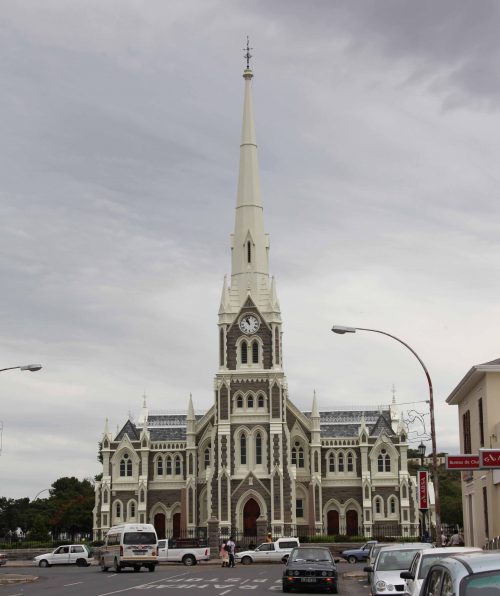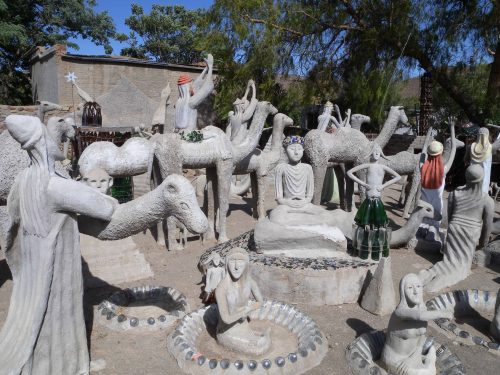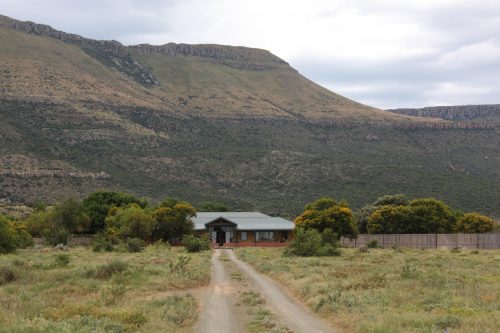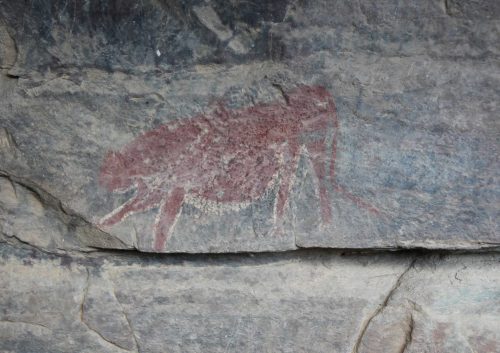
Some might consider religion and paleontology strange bedfellows but that’s the Karoo for you
Churches in the little dorps are built on shale containing petrified evidence of Mesozoic life 300 million years ago, when the Karoo was an inland sea. Then the area became volcanic and eroding sandstone carved out the mountains.
Driving through hyena-hued veld under a wide sky, I picture the geological ages spiraling back like a stairway. On the lowest steps, Moschops, Massospondylus, and Dicynodont fossils lie like forgotten toys from Earth’s lost childhood. Midway, the flintheads and rock art of the Bushmen fleck the Stone Age landing, before the sheep-herding Koi-Koi from the West Coast came to this “Place of Great Dryness” begetting generations of Koi San. As we wind through Lootsberg Pass, the rungs of today’s Robo-sapien are evident in the squashed jackal on the roadside and ubiquitous cellphone masts.

A giant cross dominates the outskirts of Graaff-Reinet where conspicuous Calvinism – think “Welcome to Faith Carwash” and “Jesus is Lord” roof insignia – reaches its zenith at the iconic 1886 Dutch Reformed Church. Heritage sites – more than 220 – showcase Cape Dutch and Victorian architecture, such as the early 19th century Old Residency Museum, worth a visit for interesting Anglo Boer War photographs, memorabilia, rifles, and vintage musical instruments.
Head northwards along Church Street to the Valley of Desolation or south to the old library museum that offers an assortment of pre-dinosaur fossils. There’s an even better collection at Nieu Bethesda’s Kitching Fossil Exploration Centre with life-sized models of the prehistoric Permian creatures that roamed the Karoo long before grasses, flowers, mammals or birds were even thought of.

While in Nieu Bethesda, don’t miss the The Owl House, once home to the brilliant but tortured Helen Martins who transformed the place into an exquisitely disturbing space where concrete sculptures fill the garden and coloured crushed glass encrusts every interior surface. Its beauty and sadness will haunt you.

Herds of antelope, zebras and cheetah roamed the grass flats of the Karoo less than 200 years ago, but after the advent of stock famers, sheep replaced the game and the grasses receded with the ovine grazing patterns. A few investors began converting struggling sheep farms into tourist safari lodges. Mark and Sarah Tompkins bought 11 farms, then restocked 27 000 hectares with cheetah, Cape Mountain Zebra, eland, kudu, buffalo, and red hartebeest to create Samara Private Game Reserve, which has South Africa’s highest concentration of Vervet monkeys per hectare and 200 bird species.
In the tangle of riverine forest en route to our Karoo Lodge accommodation, we spot baboon, bushbuck, a Brown Eagle, and a pair of black-headed herons on the 3km drive towards the restored 1800s farmhouse.

Samara has the only known Bushman rock painting of a cheetah.
The next day our Land Cruiser creaked up the steep flanks of a rugged mountain, crossing zebra-dotted grassy plains where wildebeest pranced all the way up to Eagles Rock with a dizzying drop beneath us and a knee-weakening view of the fertile Camdeboo plains spread as far as the eye can see. Filigreed with shepherd trees, it’s a place of power and ritual that fills you with wonder.
It’s also where Shell plan to frack even though the “over-mature” Karoo shale deposits are basically devoid of gas. The Treasure Karoo Action Group (TKAG) will fight them all the way.
The thought of those dark satanic drills despoiling the beauty of this sacred place cannot even be entertained!


